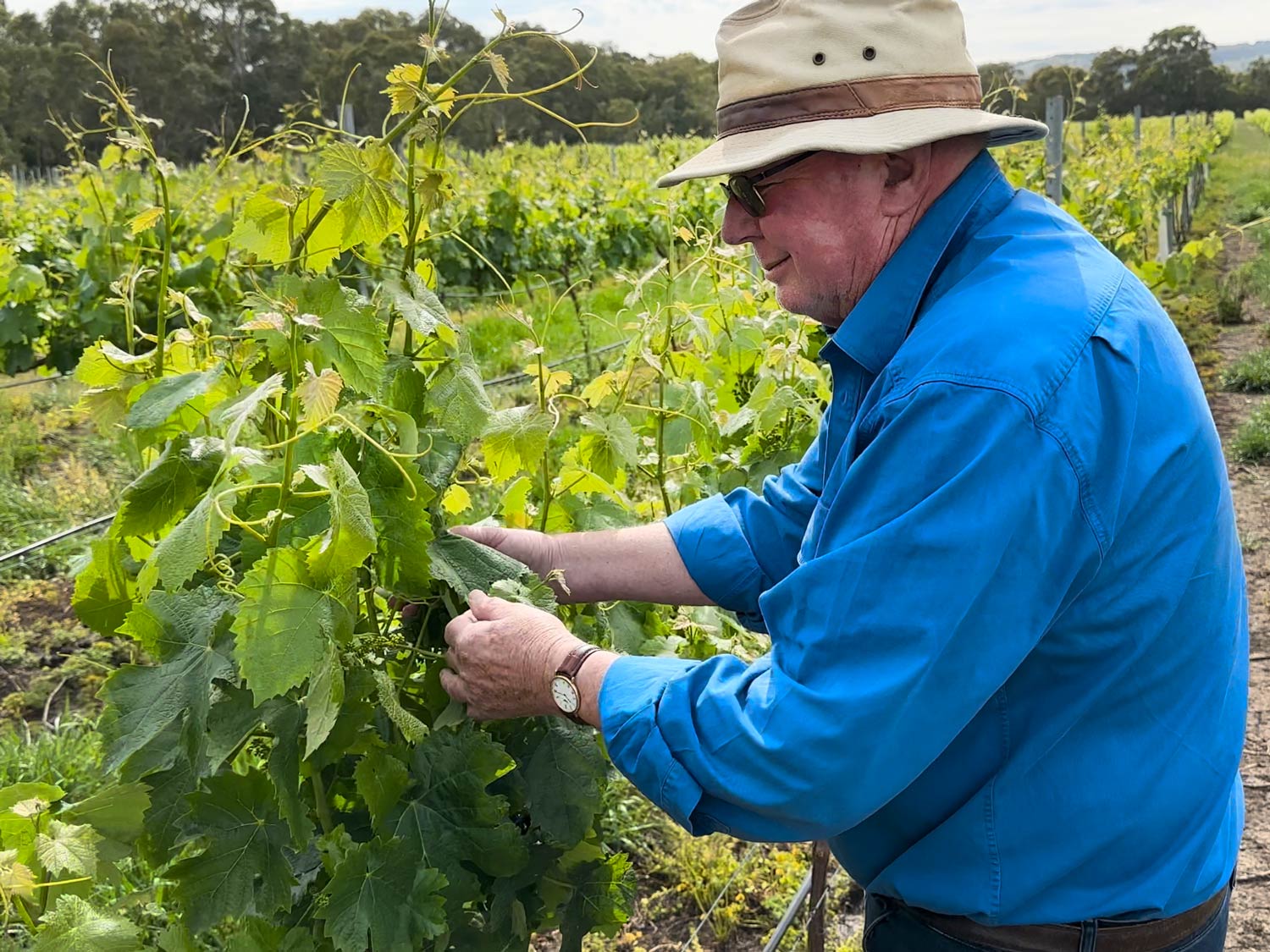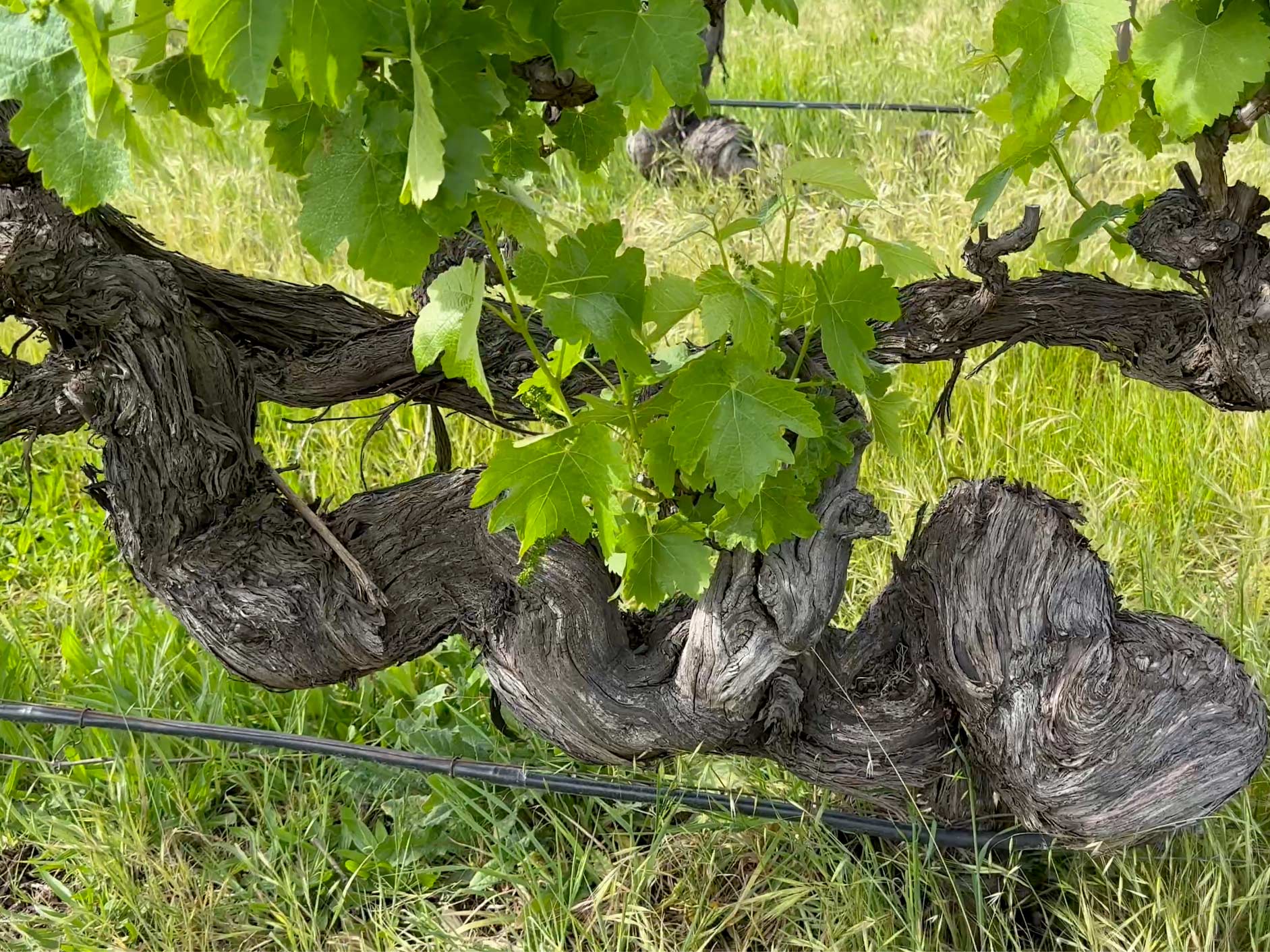The Thomas Block is the jewel in the crown for Paxton Wines, who have around half a dozen vineyards throughout McLaren Vale. The first vineyard purchased by David Paxton in 1978, this 26-hectare certified biodynamic vineyard boasts a treasure of old vine shiraz planted in 1887 – the oldest shiraz vines in McLaren Vale. Further plantings since 1979 give it a grape variety mix that also includes grenache, chardonnay, pinot gris, cabernet sauvignon, graciano, mataro, tempranillo and fiano, going into Paxton Wines. The flagship Paxton wine, the EJ Shiraz, named after David Paxton’s mother and family matriarch Elizabeth Jean, comes exclusively from the Thomas Block.
It was 1978. Hairdos were longer. Grease was the word. Olivia Newton-John and John Travolta’s duet was top of the charts, as were the Bee Gees ‘Night Fever’, and ‘Stayin’ Alive’. Bright and fruity white wine was the beverage of choice. The cask was popular. Shiraz was being pulled out to plant riesling. And young David Paxton wanted to get into the wine game with his eyes on the Thomas Block, a piece of McLaren Vale’s wine history.
Paxton’s initial venture into vineyard ownership was no small feat. Convincing Dolly Thompson, the then-custodian of the land, required not just business acumen but a personal touch that transcended conventional transactions. “I pretty much had to schmooze and court her – and note she was elderly at this stage – to convince her that I was the right person to be custodian to this beautiful block”, Paxton recalls. “I thought the deal was done but she had one last test for me, she summoned her sisters to come and approve who arrived in Jaguars and Mercs all the way from Adelaide just to check if she had done her homework correctly. When the news arrived that I had been approved, I got in my car and drove all the way to Whitmore Square to visit Dolly at home. I quickly stopped off for a bunch of flowers, only to my embarrassment when I presented them to her did I realise they were plastic! Somehow the gesture was enough and the papers were signed.”
He brought it back from significant disrepair and created a modern sustainable vineyard whilst retaining some of the most ancient vines of McLaren Vale, and returning the historic homestead and expansive gardens to their former glory. “The whole reason this vineyard has been successful and I’ve been able to dine out at all is because I became friends with Greg Trott from Wirra Wirra when I first purchased the vineyard. He subsequently introduced me to Brian Croser who told me that a little thing called chardonnay was going to explode. We went on to work together on a number of different projects but it was that advice that he first gave me that made a dream become a successful reality and put me in the position to expand my vineyard holdings and continue to breathe new life into Thomas Block.”
The uniqueness of the Thomas Block vineyard comes through not only in the stories of the people connected to it, but also its distinct terroir within McLaren Vale. Paxton describes the vineyard as having “Fairly flat deep alluvial soils with high gravel content, surprisingly cooler compared to other areas of McLaren Vale and protected from wind by the sand hills that are dotted around the area and the well-established native flora bordering the vineyard. The site is similar to neighbours Petrucci/Leask vineyards but the combination of alluvial soils and old vines is distinct to our site. It is what has allowed these old vines to survive even after decades of abandonment.”
McLaren Vale’s reputation as a leader in biodynamic and organic viticulture is well-documented, with an AWRI report highlighting that approximately 38% of vineyards in the area hold such certifications. It was 20 years ago when Paxton decided to pursue biodynamics, and being amongst the leading group in the region.
Paxton’s recount of his transformative experience at a biodynamic conference vividly illustrates the initial skepticism that often precedes significant change. “Going to the biodynamic conference in the old lunatic asylum in Beechworth in Victoria in 2004 with Ang Tolley and Toby Bekkers. We were sitting behind Max Allen who has always been a passionate advocate for biodynamics in Australia,” he says as he starts the story. “I was muttering sceptically (though clearly coherently) through some of the more out-there ideas of Nicolas Joly who opened the conference, and seemingly before the conference had even finished Max had released an article about my incredulity of the whole thing up until that point, it even made news in the UK! The ironic thing was, by the time I had heard all the practical Australian and NZ farmers and experts share their stories, I was 100% convinced and started making phone calls in the car on the way back so that we could begin conversion immediately.”
Paxton was converted, but he’s quick to dispel any myths surrounding the practice. “Most people will tell you that the improvement in wine after implementing biodynamics is subjective or that we’re just a bunch of hippies or witches running around under the moonlight, but the proof is in the glass, there’s a searing difference.”
Paxton’s philosophy around sustainability considers economic and social (community) sustainability: “The great thing about Biodynamics is that the whole principle encompasses a holistic management of the farm which does not forget the economic and social factors in this sphere. We have a great team who work hard in the vineyard performing manual tasks where others might use chemicals. This is one small way that we actively contribute to the local economy by employing locals and keeping those dollars in circulation to benefit the community around us. We also need to be economically sustainable to keep these people employed so they in turn can support their families. One of the ways we do this is by embracing technology that helps us work smarter, not harder. We are always trying new things, adapting and repurposing.”
This continues the environmental stewardship, emphasizing a deep-seated responsibility towards the land. “We are custodians of the land and our aim is to leave it in a better place than how we found it. We are continually enhancing the biodiversity surrounding our vineyard and forging ahead rejuvenating the creek bed by removing woody non-native species and replanting at every opportunity. We employ bees in our vineyards and utilise cover crops and our own biodynamic compost applications to enhance soil quality. We have recently joined SWA so that we can monitor and improve on our use of finite resources over and above everything that we are already doing.”
Paxton is acutely aware of the evolving challenges presented by climate change to viticulture, observing significant shifts in weather patterns. “Climate change is bringing more rain within violent storms and colder weather and heat spikes,” says Paxton. He then outlines his adaptive strategies to ensure the vineyard’s resilience: “Increasing canopy size where possible for protection from rain and heat. Increasing diversity of planted varieties which is an insurance policy, and nurturing vineyards in different parts of the region for the same reason. Increasing our focus on grenache as it stands up a lot better to the heat than shiraz.”
Reflecting on the intrinsic connection between the vineyard’s legacy and its present, Paxton shares a poignant insight into the decisions that shape their wine portfolio. “Some things choose themselves from the vineyards that you are custodians of. It was a no-brainer decision to keep and resurrect the old Shiraz vines planted in 1887 when I purchased the property in 1978. When it was time to commemorate the 100th birthday of my mother, Elizabeth Jean, there was nothing more fitting than the resulting wine of supercentenarian vines. Honestly, a lot of the stylistic choices we make come down to the age of a vineyard and what it can offer in terms of balance and flavour concentration. We spend a great deal of effort nurturing our vines for a fruitful and productive life, it is only fair that we let the ones that have stood the test of time flourish as individual wines in our range.”




